
Our Craft

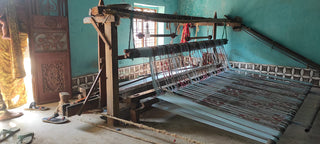
Bhagalpur Linen Weaving
The Bhagalpur cluster in India stands out for its expert silk and linen handloom weaving, a tradition that spans over five centuries. Strategically located by the Ganges, the humidity here is ideal for weaving natural fibers, a factor crucial for the high-quality production of yarns and fabrics.
In 2013, the Indian government recognized the cluster's heritage by awarding it a Geographical Indication (GI) tag. Women play a crucial role in this weaving process, including reeling and bobbin-filling. The collaborative family effort adds depth to the craftsmanship of Bhagalpur weaving.
Bhagalpur is renowned for its ability to weave linen across any GSM, a unique skill on a global scale. The handloom weaving here involves traditional techniques using charkha and pit looms, which give the textiles distinctive patterns and textures. The use of natural and eco-friendly dyes enhances the sustainability of the textiles, producing vibrant colors.
The GI tag has cemented Bhagalpur's reputation for authentic and traditional craftsmanship, making its linen and silk products highly valued by both older and younger generations who treasure handcrafted and heritage textiles.


Kashidakari of Kashmir
Kashidakari, tracing back to the 15th century in Kashmir, began with Persian-style embroidery featuring elaborate florals. This craft epitomizes local skill, with stitches and motifs of the region's flora and fauna. Our modern interpretation seeks to honor the artisans who've kept this tradition alive for generations.
This embroidery comprises styles like sozni, kani, amli, and more, unified by their embroidery techniques and motifs, which include butas and Chinar leaves. It captures Kashmir's essence with intricate, colorful patterns. The term "kashidakari," meaning 'flow freely' in Persian, reflects the artisans' creativity.
In Kashmir, kashidakari is mainly taught from father to son, with men being primary embroiderers. The process starts with sketching designs on fabric using a perforated sheet and colored powder. The embroiderer, often also the designer, uses an aari needle for detailed work. Once embroidered, the marks are washed, leaving only the exquisite needlework.
Kashidakari features diverse styles like Jamawar Patterns with elaborate designs, Jalidar Designs with mesh patterns, and Bootidar with paisley-filled patterns. Interestingly, there are no left-handed craftsmen in this tradition. While men handle the embroidery, women prepare the yarn, making it a family craft.
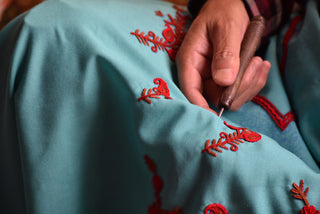

Aari Hand Embroidery
Aari Embroidery, deeply rooted in the Indian Embroidered Tradition, dates back to the 12th century in Gujarat. Initially developed by leatherworkers, particularly the 'Mochi' community, it was first used to embellish footwear, including the traditional 'Mojdi.' This form of embroidery was not exclusive to any one community; it was a court embroidery for royalty, crafted exclusively by male artisans.
Aari embroidery gained prominence under Mughal emperors, influenced by international design elements from China and England. In the 17th century, it adorned royal garments with oriental landscapes and European botanical motifs. The technique, exclusive to male artisans, was primarily executed on silk and cotton fabrics. The name "Aari" comes from the 'Aar' needle used in this embroidery. The process involves transferring patterns drawn on paper to fabric, which is then meticulously embroidered on a wooden frame.
Artisans, usually sitting on the floor, use the Aari needle to create fine chain stitches, often incorporating beads, sequins, and 'zari' (gold, silver, and copper threads). This method requires high skill, patience, and precision, with artisans focusing on detailed designs and color gradations.
Having spread across India, Aari work has left a mark on traditional attire in various states, enhancing garments like silk sarees in Andhra Pradesh. Skilled women, often from traditional art backgrounds, help sustain this craft by passing on their knowledge. Supported by the government, these artisans not only preserve heritage but also contribute to the contemporary popularity of Aari embroidery, weaving a story that bridges centuries, cultures, and regions.


Kasuti Embroidery of Karnataka
Kasuti is a traditional form of embroidery from Karnataka, India, tracing its origins to the 7th century AD. The name 'Kasuti' combines the Kannada words 'Kai' (hand) and 'Suti' (cotton thread), reflecting its handcrafted nature. This art form flourished particularly under the Chalukya dynasty and later during the Mysore Kingdom in the 17th century, with women artisans mastering the craft among other art forms.
Deeply integrated into the local culture, Kasuti reflects themes commonly found in South Indian temple architecture and natural motifs, including flora and fauna. The intricate patterns often depict chariots, palanquins, lamps, and conch shells, with a repertoire of animal and bird motifs like elephants, deer, peacocks, and parrots, symbolizing various cultural narratives.
The craft of Kasuti is known for its complexity and labor-intensive process, involving a meticulous counting of threads on the cloth, ensuring precision and symmetry without the need for pre-drawn patterns. This method emphasizes the artisan's skill and ability to visualize the design directly on the fabric. The absence of knots in the embroidery allows for a clean finish on both sides of the embroidered fabric.
Kasuti employs four distinct stitches: Gavanthi (a double running stitch), Murgi (zig-zag pattern), Negi (running stitch), and Menthi (cross-stitch). These stitches are applied in different directions to form the design, with each stitch contributing to the overall aesthetic and texture of the embroidery.


Kamal Kadai from Andhra Pradesh
Kamal Kadai is a distinctive embroidery style from Andhra Pradesh, India, renowned for its intricate 3D floral motifs, particularly the lotus, creating a step-like geometric pattern. This art form, dating back to the early 16th century Vijayanagar Empire under Krishnadevaraya, flourished with royal patronage. The term "Kamal Kadai" translates to 'Lotus Embroidery' in Hindi and Urdu, reflecting its focus on creating symmetrical lotus petals using a grid technique.
Characteristic patterns include geometric floral designs with four or five petals and leaves crafted using the Woven Trellis Stitch. These designs may have a twisted or open center, with variations in the number of spokes and the addition of beads for decorative and structural purposes.
To create Kamal Kadai, fabric is placed in a frame, and a geometrical pattern, usually a square, is drawn. The thickness of the petals is determined by marking points at each corner. The petals are then formed by weaving the thread through these points, creating straight lines. Additional stitches complete the designs, with beads and gemstones often added for embellishment.
Kamal Kadai is a revered tradition in Indian embroidery, symbolizing rich cultural heritage. However, the community of artisans skilled in this technique has significantly declined over recent decades. With only a few practitioners left, primarily in Hyderabad, there's a growing need to protect and promote this exquisite craft to ensure its survival and appreciation in modern times.

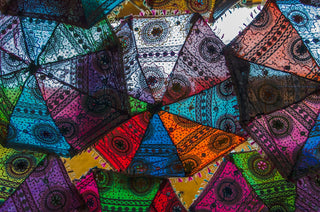
Chandua of Odisha
Chandua appliqué work is a craft with origins in the 12th century linked to Hindu temples. The base materials for Chandua vary, including waterproof fabric for umbrellas and velvet for tents, adorned with mythical and natural figures. Artisans use several stitching techniques to assemble the designs. Chandua has since expanded beyond temple art, now appearing in household and ceremonial items.
Modern Chandua embraces stylized flora, fauna, and abstract techniques, with tailors (Darjis) viewing their work as service to the Lord. Around 15,000 artisans in Puri and Khordha districts, 60% of whom are women, depend on this craft for their livelihood. What began as temple art has evolved into a versatile craft, now applied in various contexts from ceremonial items to urban utility products. This flexibility allows artisans to innovate, merging tradition with contemporary trends, ensuring the craft's relevance and appeal.
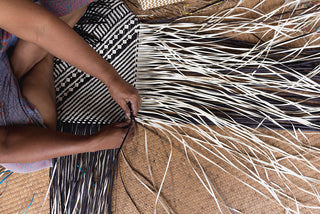

Raffia of Central Africa
Raffia, derived from the leaves of the raffia palm, is a natural fiber with a rich history and a wide array of uses in the realm of crafts. It's versatile, being used for making high-quality cloth, robust baskets, intricately woven mats, and even in embroidered textiles.
In the Congo region and Central Africa, raffia was integral to traditional textiles. In contemporary needlework, raffia has become a popular alternative to traditional threads like silk or linen due to its durability and silk-like pliability. It's used in various embroidery techniques on fabrics like linen, rough oatmeal cloth, and coarse toweling.
Ceremonial raffia dance skirts and embroidered cloth panels represent a fusion of craftsmanship and cultural expression. Men weave these on upright single-heddle looms, producing plain squares of raffia cloth. Women then employ intricate decorative techniques, including cut-pile embroidery, using local plant dyes to create a rich color palette. The precision in inserting raffia strands through the cloth during embroidery highlights the skill and meticulous craftsmanship of the artisans.


Rajbansi Royal Weaving
Jute, often referred to as the golden fiber, is extensively cultivated in the humid and wetlands of West Bengal, which produces about 80% of the world's jute. The Rajbanshi women have mastered the art of transforming this locally grown fiber into exquisite textiles.
The process of jute weaving in West Bengal involves several steps. It starts with the extraction of fibers from locally grown jute plants. After cutting, soaking, seasoning, and sun-drying, these fibers are hand-rolled into strands, dyed, and then woven into intricate designs on homemade looms. The weaving process itself is a vital aspect of the craft, carried out on specially designed looms composed of bamboo and various wooden components.
This weaving is not just a craft; it's a cultural practice. Women play a central role, using paat shrubs as a cost-effective raw material. The transformation of the strands through dyeing adds vibrant colors to the natural fibers, leading to the creation of beautiful mats and other products.


Gond Tribal Art of Madhya Pradesh
Gond Art, a vibrant and intricate form of painting, originates from the Gond tribe, primarily located in central India. The name "Gond" comes from the Dravidian expression "kond," meaning "the green mountain," which aptly reflects the tribe's deep connection with nature. This connection with nature is also famously represented in Rudyard Kipling's character Mowgli, based on the Gondi tribe.
Gond Art reflects the Gondi tribe's intimate relationship with nature, drawing inspiration from their surroundings and beliefs that emphasize the interconnectedness of all life forms. This art form is not just an aesthetic expression but a profound representation of the tribe's life lessons, concepts of time, and the elements of nature. Influential works like "The London Jungle Book" and "Nightlife of Trees" highlight the Gondi tribe's philosophical perspectives on nature and life.
The art is known for its use of vibrant colors and intricate patterns, often employing techniques like line drawings, filling with dots, and chain drawings to create illusions of multiple colors on a single base. The colors used in Gond Art are derived from natural sources, reinforcing the tribe's symbiotic relationship with their environment.
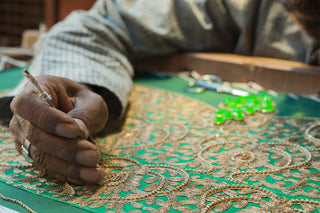

Zardozi of India
Zardozi embroidery, a luxurious and opulent craft from India, is a testament to the country's rich artistic heritage. The name 'Zardozi' comes from two Persian words, "zar" (gold) and "dozi" (sewing), and the craft is characterized by its heavy metal embroidery on fabrics like silk, satin, or velvet, often embellished with gold and silver threads, pearls, beads, and precious stones.
Originally done with real gold leaves and pure silver wires, the craft has adapted over time, now often using copper wire with gold or silver polish along with silk thread. Despite facing a decline due to the loss of royal patronage and the rise of industrialization, Zardozi experienced a revival after India's independence in 1947.
Zardozi's allure lies in its intricate craftsmanship, where gold or silver alloy is transformed into a flattened wire, or "badla," which is then wrapped around silk or cotton thread to create a flexible composite thread. Despite some mechanization, Zardozi remains predominantly a handcrafted, labor-intensive process.
Today, Zardozi has expanded beyond traditional clothing to accessories like purses, belts, shawls, and shoes. Innovations in machinery and textile blends, along with the use of natural raw materials instead of gold and silver wires, have made Zardozi more accessible to a broader audience.


Sanganeri Block Printing from Rajasthan
Sanganer, located on the outskirts of Jaipur in Rajasthan, is renowned for its ancient craft of hand block printing, a tradition deeply rooted in the region's history, culture, and geography. Sanganer was chosen as a major center for block printing due to its abundance of soft water and suitable clay for sun-bleaching fabrics. The village's strategic location, with a river providing a consistent water source, was ideal for washing and dyeing fabrics.
Sanganeri prints are distinguished by their decorative floral patterns, including Buta (larger motifs), Buti (smaller motifs), Bel (creepers), and Jaal (floral nets). These designs draw inspiration from natural elements like lotus, mango, and peacocks. The dyeing process in Sanganer employs both natural and eco-friendly dyes, with a range of colors derived from sources like Lac, Harda, Indigo, Rhubarb, Kamala, Manju phal, Catechu, Pomegranate, Madder, and Aal.
Today, approximately 4500 artisans continue this craft in and around Sanganer. In 2010, Sanganeri print was awarded the Geographical Indication tag, recognizing its unique identity and preserving its heritage.


Linen Weaving of Phulia
In Phulia, a town in West Bengal, India, known for its rich hand-weaving tradition, linen weaving has become a symbol of artistic excellence. This tradition dates back to the time of the Partition of India in 1947, when skilled weavers from Bangladesh migrated to the region. They brought with them their ancestral weaving traditions, particularly in jacquard and jamdani styles, which were inspired by the Tangail sari heritage of Bangladesh.
The term "tant" refers to the handlooms used in Bengal for weaving cotton sarees, dhotis, and other garments. The history of handloom saree weaving in this region dates back to the 15th century in Shantipur, another town in West Bengal. While the royal class wore muslins, the common people wore cotton or tant sarees.
The actual weaving is done on traditional pit looms. Artisans can weave approximately 3 meters of linen and 4 meters of plain weave cotton per day. However, this craft faces challenges, as the number of skilled weavers is dwindling, threatening not just the handloom industry but also the preservation of age-old techniques. For instance, intricate weaves like jamdani and specialized fabrics like the rare 250 count muslin are at risk, with only a few weavers capable of producing such fine cloth. Linen weaving, involving a brittle and unconventional fiber in Indian weaving, faces similar challenges, with only a small number of proficient weavers left to carry on this legacy within the weaving society in Phulia.


Irish Embroidery
The Irish machine is recognized for its unique single, hooked needle that creates a zig-zag stitch similar to a satin stitch. This machine has been instrumental in replicating the finesse of hand-made embroidery. The development of zig-zag machines, which preceded the Irish machine, dates back to the mid-nineteenth century. These early machines required skillful manipulation and were time-consuming, but they have since evolved into the advanced zig-zag stitch machines known today.
This type of embroidery machine is especially popular for art and free-style embroidery, where the fabric is stretched over a hoop and the hoop's movement, controlled by the embroiderer, determines the size and direction of the stitches.


Screen Printing
Screen printing originated in ancient China around 1000 AD and spread globally, gaining prominence in Europe in the 18th century. It was introduced to India in the 20th century, where it became an extension of the country’s rich textile traditions. The craft involves pushing ink through a mesh screen onto fabric using stencils to create intricate patterns. Artisans require skills in design alignment, dye mixing, and screen preparation for precise, high-quality prints. Today, screen printing is widely used in homeware,
producing vibrant cushion covers, curtains, and tablecloths, merging traditional motifs with modern aesthetics for versatile décor.


Flatweave Rug Weaving
Flatweave rugs have a deep-rooted history in India, with evidence dating back to the 1st–3rd centuries AD. Flatweave rugs, locally known as daris or dhurries, were integral to Indian life, used by both royalty and commoners as floor coverings, bedding, or even packaging material. Geometric patterns like stripes, chevrons, and diamonds are hallmarks of Indian flatweaves, reflecting both practicality and artistry. Some dhurries feature stylized flowers, animals, or symbolic motifs, influenced by Persian and local traditions. Cotton is most common, but wool, jute, and silk are also used, depending on the region and intended use.
Indian flatweave rugs are made using a tapestry technique which involves:
- Weft-faced Weaving: Horizontal weft threads are woven tightly over and under vertical warp threads, concealing the warps and creating the pattern. This makes the rugs reversible and highly durable.
- Dovetailing and Interlocking: Used to create sharp color changes and geometric patterns, especially in dhurries.
The resilience of the flatweave rug tradition in India lies in its adaptability, strong community ties, and the pride artisans take in their heritage. The result is a living tradition, continually refreshed as it is handed down from one generation to the next, ensuring both the survival of ancient techniques and the ongoing evolution of design

